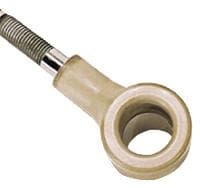Description
The Rosemount 226 toroidal conductivity sensor measures conductivity in highly conductive liquids up to 2 S/cm (2,000,000 μS/cm).
This toroidal/inductive sensor has a robust fouling-resistant design which makes it ideal for measuring conductivity in harsh, corrosive and fibrous liquid applications.
Features- Plugging resistant and suitable for liquids containing high levels of suspended solids due to large bore design
- High vibration tolerance with reinforced internal metal frame design
- Constructed with highly corrosion-resistant glass-filled PEEK
- Robust measurements - insensitive to process flow and direction
- 1" Male NPT process connection mounting adapter for submersion type installations
- Can be inserted through any user supplied flange by using optional process connection mounting adapter
Specifications
Documentation
Documentation
Data Sheets
- Application Data Sheet: Calibrating Toroidal Conductivity Sensors pdf 145 KB
- Application Data Sheet: Conductivity in White Liquor pdf 71 KB
- Application Data Sheet: Conductivity Measurement in Oil Drilling pdf 98 KB
- Application Data Sheet: Digester Control in the Kraft Process pdf 114 KB
- Application Data Sheet: Interface Detection and Level Control in Serparators pdf 626 KB
- Rosemount Analytical Model 226 Conductivity Sensor Datasheet PDF pdf 675 KB
- Technical Data Sheet: Toroidal Conductivity Sensor Addendum Transmitter Compatibility pdf 729 KB
Product Manuals
Certificates & Approvals
- Product Certificate: 226 Toroidal Conductivity Sensor CRN-Alberta 0F13670-2 pdf 1.3 MB
- Product Certificate: 226 Toroidal Conductivity Sensor CRN-British Columbia 0f13670-21 pdf 24 KB
- Product Certificate: 226 Toroidal Conductivity Sensor CRN-Manitoba 0F13670-24 pdf 1.3 MB
- Product Certificate: 226 Toroidal Conductivity Sensor CRN-NB, NS, PEI, NL, YT, NT, NU 0F13670-27890YTN pdf 6.1 MB
- Product Certificate: 226 Toroidal Conductivity Sensor CRN-Ontario 0F13670-24 pdf 1.4 MB
- Product Certificate: 226 Toroidal Conductivity Sensor CRN-Quebec CSA-0F13670-26 pdf 1.9 MB
- Product Certificate: 226 Toroidal Conductivity Sensor CRN-Saskatchewan 0F13670-23 pdf 1.4 MB

